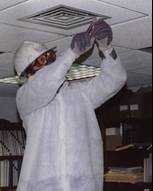Building Environment

Protecting building environments presents many challenges to environmental health practitioners. Maintaining a secure and healthy building environment requires an in-depth knowledge of building components and understanding the vulnerability of these components to contamination.
This section provides resources on protecting building environments as well as general links on improving indoor air quality.
CDC Emergency Preparedness and Response – how to prepare, plan, and respond to healthy building environments after disasters
- After a Flood
- Cleanup of Flood Water After a Disaster or Emergency
- Clean Up Safely After a Natural Disaster
- Cleaning and Sanitizing With Bleach after an Emergency
- Mold After a Disaster
Environmental Health Training in Emergency Response (EHTER) – 10 modules that focus on key environmental health issues and challenges for emergency response
Terrorism Response – Safeguarding Building Ventilation (CDC National Institute for Occupational Safety and Health [NIOSH])
- Guidance for Filtration and Air-Cleaning Systems to Protect Building Environments from Airborne Chemical, Biological, or Radiological Attacks – preventive measures that building owners and managers should use to prepare and protect building air environments
- Guidance for Protecting Building Environments from Airborne Chemical, Biological, or Radiological Attacks – short-term actions that building owners and managers can take to protect occupants from a release of contaminants affecting building environments
Links to information from outside CDC
Advice for Safeguarding Buildings Against Chemical or Biological Attack (Lawrence Berkeley National Laboratory)
American Society of Heating, Refrigerating, and Air-Conditioning Engineers (ASHRAE)
- Guidance for Building Security – guide to reduce the health and safety risks of occupants in buildings subjected to terrorism
- Risk Management Guidance for Health, Safety, and Environmental Security Under Extraordinary Incidents
FEMA Library (Federal Emergency Management Agency [FEMA]) – searchable database of guides
- E155 – Building Design for Homeland Security
- FEMA 426 – Reference Manual to Mitigate Potential Terrorist Attacks Against Buildings
- FEMA 427 – Primer for Design of Commercial Buildings to Mitigate Terrorist Attacks
- FEMA 428 – Primer to Design Safe School Projects in Case of Terrorist Attacks
- FEMA 429 – Insurance, Finance, and Regulation Primer for Terrorism Risk Management in Buildings
Flooding (Environmental Protection Agency [EPA]) – general information to help people in flooded areas recover and reduce risks caused by a flood
Indoor Air Quality (Environmental Protection Agency [EPA] Office of Air and Radiation) – guides to reduce human health risks posed by contaminants in indoor environments
- An Introduction to Indoor Air Quality (IAQ)
- Healthy Buildings, Healthy People: A Vision for the 21st Century
- Indoor Air Quality Tools for Schools Kit
- Page last reviewed: October 1, 2009
- Page last updated: July 20, 2016
- Content source:


 ShareCompartir
ShareCompartir